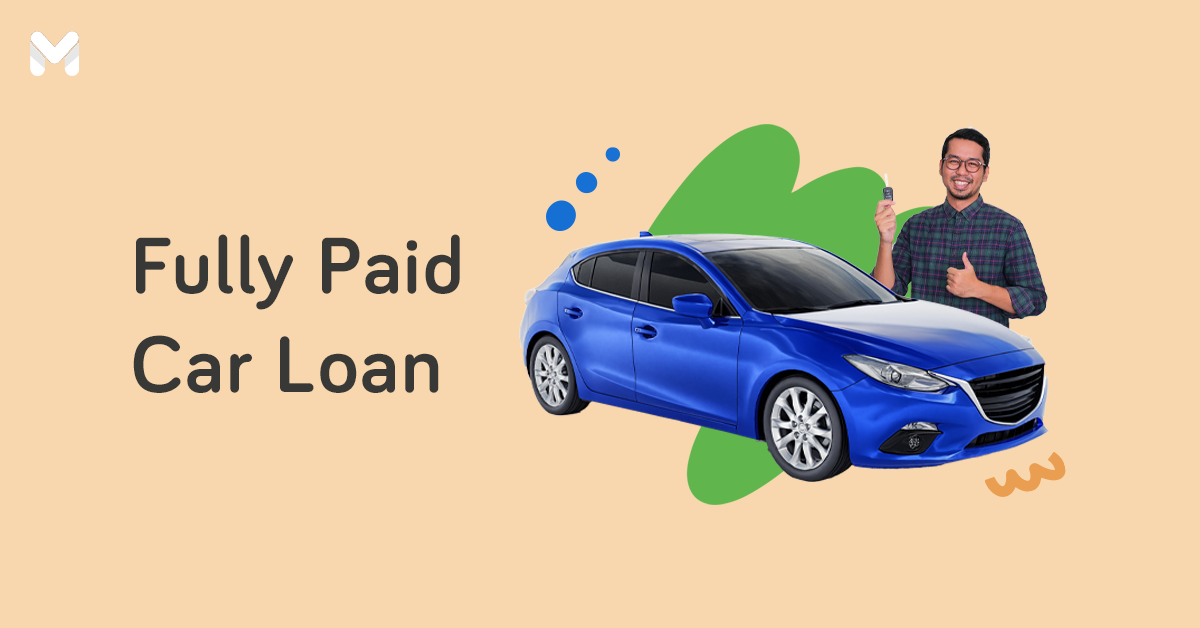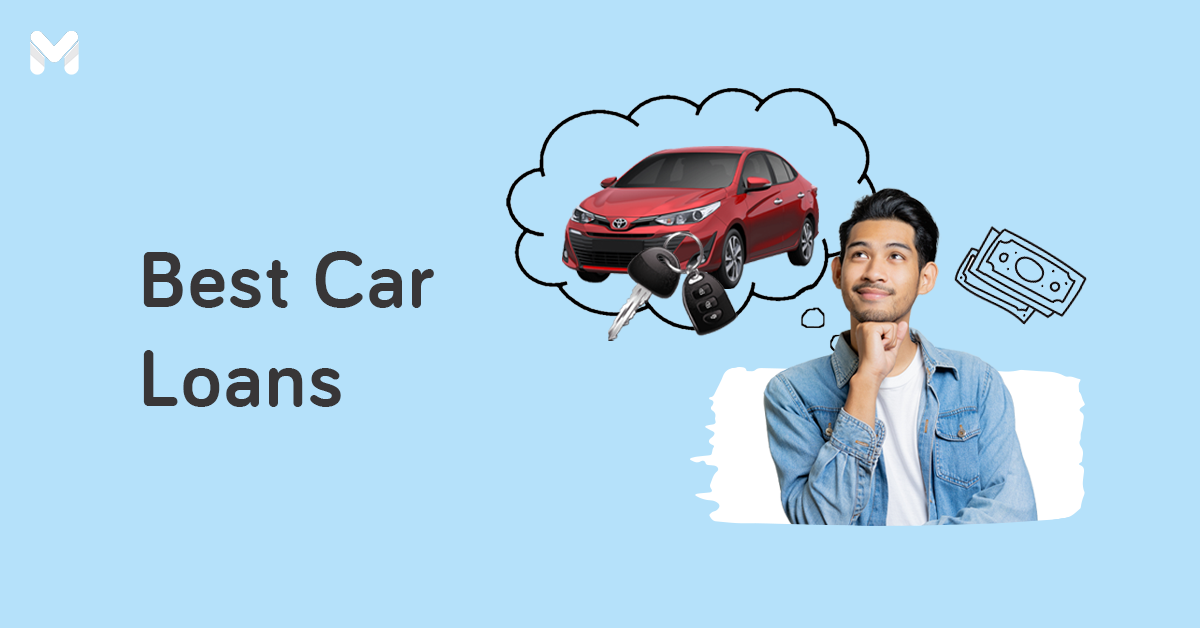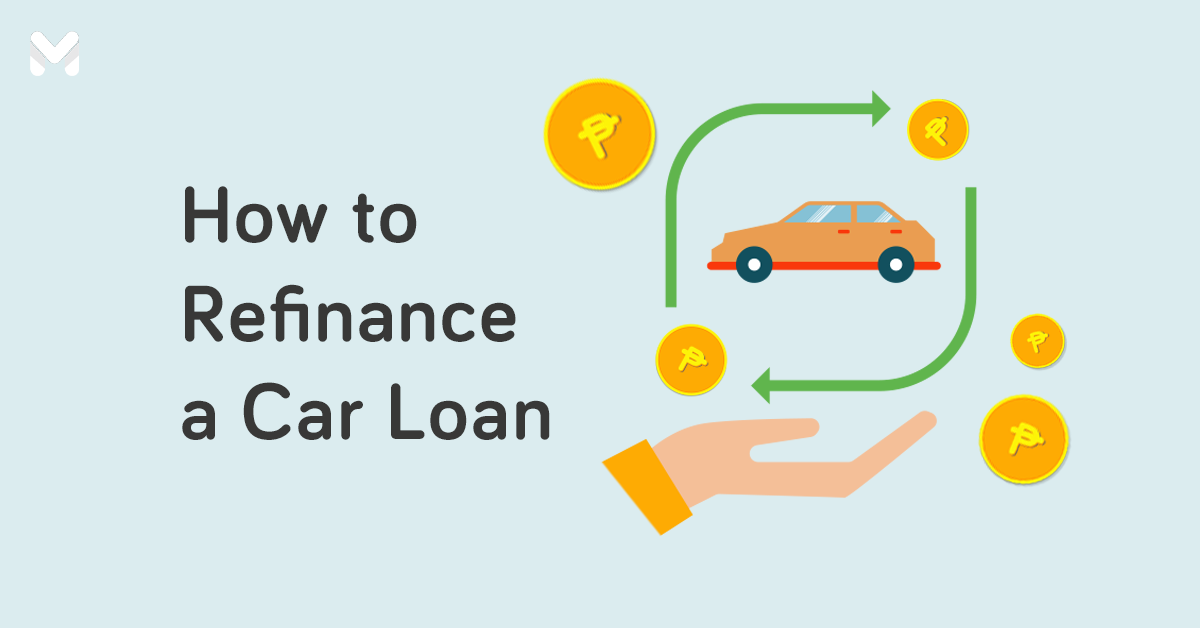For many Filipinos, buying a car is something to cross off their bucket list. Getting that first set of wheels means enjoying comfort, convenience, and practicality.
But you need money—lots of it—for this sizable investment. The cheapest sedan in the market today costs over half a million pesos. Even if you have that amount in the bank, you shouldn't spend it all on a car.
It's a good thing the car loan process is simple. With a car financing scheme, you can buy your dream car without making a full cash payment.
How Does Car Financing Work?
You probably know how car financing works from friends or family members who own cars. But how does a car loan work in the Philippines exactly?
With car financing, a bank or financial institution lends you the money to pay for the car. This loan breaks up the cost into monthly payments over a period of time, making a car purchase more affordable.[1] Usually, you need to make a down payment equivalent to a certain percentage of the car loan amount.
Car loans in the Philippines charge interest and other processing fees. The car is the loan collateral, which means the bank or the financial institution can repossess the vehicle if you can’t make your monthly payments.
5 Car Financing Options in the Philippines and How They Work

Did you know that there's more than one source of car financing in the Philippines? Securing a car financing option is essential to the car loan process. Here are a few to choose from:
👉 Bank Financing
In this car financing scheme, the bank or a lending company lends you a specific amount so you can buy a car. You’ll then pay the borrowed amount in a series of monthly payments over the tenure or period of the loan, generally between 12 and 60 months. Other than repaying the loan amount, you’ll also pay the interest.
Bank financing is also known as direct lending because the car buyer gets a loan directly from a bank instead of going through the dealership.
For example, you can use a Security Bank Car Loan to borrow as much as 80% of the purchase price for brand-new vehicles and up to 70% of the appraised value for secondhand cars.
You can make a down payment for as low as 20% of the purchase price. Pay for up to 60 months for a brand-new car and up to 48 months for a secondhand unit.
_1200x628_.png?width=615&height=322&name=Security_Bank_Auto_Loan_Main_KV_(May_2024)_1200x628_.png)
Approval time typically takes three to five banking days. Security Bank’s Car Loan also includes a free one-year car insurance coverage.
Pros of Bank Financing
Bank financing is a better option for purchases that require a higher loan amount, like a car purchase. Moreover, you can compare car loans from different banks and enjoy a more personalized service.
Aside from the higher amount, banks also offer lower interest rates than dealer financing. Let’s take Security Bank’s brand-new car loan rates as an example. If you purchase a new car with a 60-month term, the standard interest rate is 37.63%, or 36.38% if you make a one-month advance.
Cons of Bank Financing
Of course, there’s a downside to bank financing as well. For one, car loan approval may take a few days.
Getting approved for bank financing is also more challenging because you need a good credit history or a good credit standing with the bank. It also requires a higher down payment than dealer financing.
Read more: Own Your Dream Car: Best Banks for a Car Loan in the Philippines
👉 Dealership Financing
Another way to pay for a vehicle purchase is through dealership financing. It's the best option if you prefer the convenience of buying and funding your car in just one place.
Essentially, there's a contract where you agree to pay your dealer the loan amount plus interest. The dealer’s partner bank or lender processes the loan and collects your payments.
Pros of Dealership Financing
Dealership financing makes the car loan process easier and faster and offers car buyers convenience. You can finish the vehicle purchase and financing in one location and transaction, usually at the dealership showroom or office. Usually, there are freebies thrown in as well.
Partner banks and lending companies offer various car financing options, so you can negotiate. You can also get a lower down payment with dealership financing.
Cons of Dealership Financing
Some drawbacks of dealership financing include higher interest rates and hidden charges, which means higher financing costs. Also, like a car loan from a bank with a long repayment period, your car will depreciate after you pay it off.
👉 Credit Card
Using a credit card to buy a car is possible only if your credit limit is high enough to cover the cost. Some dealers may take a portion of the car’s selling price to be charged to the credit card.
The dealer can arrange this transaction, but it requires the issuing bank's approval. Remember that not all dealerships accept this car financing scheme via credit card.
On top of that, there are many fees you may need to cover.
Pros of Credit Card Payment
With a car purchase costing hundreds of thousands of pesos, you can earn thousands of credit card points, miles, or cashback. However, buying a car with your credit card only works if you immediately pay off your balance. Otherwise, the interest will accumulate and make the rewards pointless.
Cons of Credit Card Payment
As credit card interest rates are higher than those of regular car loans or dealership financing, expect to pay more on interest. The interest can be staggering if you can’t fully pay off your credit card balance after buying a car.
Moreover, an expensive purchase like a car can increase your credit utilization drastically, negatively impacting your credit score.
👉 Home Equity Loan
This car financing option in the Philippines enables you to borrow money against your home's equity or appraised value. You can use the cash from a home equity loan to buy a car.
Pros of Home Equity Loan for a Car Purchase
Enjoy a longer repayment term for a home equity loan. While car loans usually last five years, home equity loans can take as long as 30 years, with lower monthly payments.
Cons of Home Equity Loan for Car Purchase
The risk of your home getting foreclosed is high, especially if you can’t make your repayments.
You may have an extended repayment period and lower monthly payments, but remember that the value of a car doesn’t appreciate over time. A car will lose between 15% and 20% of its value yearly.[2] As a depreciating asset, it won’t be worth much after you pay it off.
👉 Upfront Cash Payment
Then, of course, there’s upfront cash payment, the car financing option everyone would like to avail of if they had the resources. You’re paying for a car in full and in cash, so you don’t have to apply for a car loan and make monthly repayments. It’s like buying something in a store and immediately going home with it!
Pros of Cash Payment
When you buy a car in cash, you don’t need to worry about your budget and whether you can make your monthly repayments. Once you pay for the vehicle, you already own it.
As such, you don’t have to pay interest and loan processing fees. You can even enjoy huge discounts and freebies when you pay in cash.
Cons of Cash Payment
Paying your car’s monthly amortizations can help build your credit history. If you pay in cash, you can’t use your monthly repayments to build credit.
You also part with a significant amount of money when you make an upfront cash payment. Instead of using it for emergencies, savings, investments, or paying off other debts, you just used it to buy a car.
The Car Loan Process in the Philippines in 6 Steps

You need to know the car loan process if it’s your first time getting a car. Save yourself the hassle and ensure a quick approval and release.
Step 1: Check If You're Qualified for a Car Loan
Start by checking if you meet the bank's car loan requirements. Find out the minimum salary for a car loan in the Philippines. More importantly, ensure a good credit score to get pre-qualified for a loan.
✔️ Car Loan Eligibility Requirements
Generally, banks in the Philippines accept auto loan applications from borrowers with these minimum qualifications:
- Age: 21 years old (not older than 65 when the auto loan matures)
- Citizenship:
- Filipino citizens living in the Philippines and abroad (including OFWs)
- Foreign residents in the Philippines with qualified Filipino co-borrowers
- Monthly salary or household income: At least ₱40,000
- Employment/Business status: Two years of employment or profitable business operation
✔️ Good Credit Score
As a first-time borrower, you must know that your credit score matters in your loan application. Banks use credit scores to evaluate a borrower's ability to repay a loan.
If your credit score is high, you'll likely get approved for a loan with a low interest rate. Check your credit score—and repair or correct it if necessary—before you apply for an auto loan.
✔️ Auto Loan Pre-Qualification
Getting pre-qualified lets you know if you're ready to apply for a car loan in the Philippines and how much you can afford to borrow. Most banks have a free online pre-qualification test on their websites for potential borrowers.
- Security Bank Auto Loan Pre-Approval Quiz[3]
- Metrobank Car Loan Pre-Screening Checklist[4]
- PSBank Auto Loan with Prime Rebate Pre-Screening Checklist[5]
Step 2: Compute How Much You Can Borrow
How much can you afford to pay monthly without living paycheck to paycheck? Remember that monthly loan payments will take a portion of your budget for the next three to six years.
If you fail to repay your loan for a long time, the bank will take your car away. Ensure that the amount you borrow matches your budget to avoid vehicle repossession.
To know the amount you can realistically afford, check out the factors that affect the cost of a loan for car financing:
- Vehicle type and price: Will you buy a brand-new or used car? What car make and model are you considering? Make sure your choices are well within your budget.
- Down payment: Banks charge a down payment of 20% to 50% of a vehicle's selling price. Your chosen down payment will affect the amount of your monthly amortization. The higher it is, the less you'll borrow from the bank. You'll therefore save more on interest payments if you choose a higher down payment.
- Length of the loan: Car loans in the Philippines offer repayment terms ranging from one to six years. A shorter term raises your monthly amortization, but you'll pay less interest over time. On the other hand, a longer term leads to lower amortization, but you'll pay more interest.
Also, consider other car costs, such as insurance, fuel, maintenance, and repairs. Although they aren't included in your loan repayments, car ownership costs are unavoidable expenses that comprise part of your budget. You need to pay attention to them to make full and timely monthly payments for your loan.
Read more: Car Loan Restructure in the Philippines: Why You Should Apply for One and How to Do It
👉 How to Compute a Car Loan in the Philippines
Most banks in the Philippines have loan calculators on their respective websites. Use them to estimate the cost of borrowing money for your car purchase.
- Security Bank Car Loan Calculator[6]
- UnionBank Auto Loan Calculator[7]
- RCBC Auto Loan Calculator[8]
Just choose your preferred vehicle type, down payment, and repayment term. The loan calculator may also ask you to enter the vehicle's selling price and other related information.
The results will show you the loan amount (usually 50% to 80% of a car's selling price), the down payment amount, and monthly amortization. You can re-compute to see how these amounts will change if, say, you select a higher or lower down payment and a longer or shorter term.
Using Security Bank’s car loan calculator, let’s try a sample computation:

Suppose you want to purchase a brand-new car worth ₱1.5 million. With a net income of ₱60,000, you plan to put up a 20% down payment and pay in 60 months.
Security Bank will finance ₱1.2 million. Your down payment will amount to ₱300,000, with a monthly amortization of ₱27,276.
Step 3: Compare Loans
Researching and comparing auto loans in the Philippines allows you to determine which is best for your budget. Specifically, check the interest rate, loan amount, down payment, and repayment terms of different lenders.
Consider also the type of vehicle you can take out loans for. Security Bank, RCBC, PSBank, BPI, EastWest, and China Bank Savings offer loans for brand-new and secondhand cars for personal and business use.
Banks set different maximum age limits for used cars, too. For example, Security Bank accommodates vehicles up to 11 years old.
On the other hand, Metrobank doesn't accept secondhand cars as collateral for a vehicle loan. Neither does it allow borrowers to use loaned cars as taxis or ride-hailing services.
Looking for the best car financing option can be complicated and time-consuming. Save time and effort when you apply for a Security Bank Car Loan via Moneymax.
Step 4: Complete the Car Loan Requirements
One last thing you must do before filing a loan application is to prepare all the documents to prove your identity and income.
Here are the typical car loan requirements in the Philippines:
- Valid government-issued IDs (passport, driver's license, SSS ID/UMID, OFW ID, Alien Certificate of Registration, etc.)
- Certificate of employment, payslip, or income tax return (ITR) for local employees
- Business registration certificate, business permit, bank statements, ITR, and audited financial statements for self-employed individuals
- Proof of remittance, payslips, or certificate of employment for OFWs
Step 5: Submit Your Car Loan Application
Most banks that offer loans for vehicle purchases accept both walk-in and online applications. Submit your completed application form and supporting documents at the nearest branch.
However, for more convenience, use the bank's online facility for a loan application. Just note that if you apply online, you'll have to scan or take photos of your documents and upload the images on the bank's website.
Step 6: Wait for the Car Loan Approval and Release
How many days for a car loan approval in the Philippines? Banks in the Philippines take a few banking days to process and decide on an auto loan application. If your loan is approved, the bank will require you to do the following before it's released:
- Sign your loan documents
- Submit any additional requirements
- Pay the down payment and other loan-related fees such as chattel mortgage fee, handling fee, and one-month advance payment (if applicable)
- Get a comprehensive car insurance policy
You have two choices when getting car insurance: through the bank or an online broker. Although the bank offers convenience, an online broker like Moneymax can help you find the best car insurance quotes and deals.
After completing all these post-approval steps, you can finally drive home your new four-wheeled baby!
Read more: Fully Paid Car Loan? Here’s What You Should Do Next
Car Loan Process: FAQs

1. Is getting a loan to finance an auto a good idea?
Yes! The most significant benefit is owning a car without paying the total price upfront. While paying in cash means getting significant discounts or not paying interest, not everyone can afford this mode of payment. An auto loan is an ideal solution.
2. Who becomes the owner of the car financed through a loan?
When you finance a car purchase through an auto loan, the bank or the lending company becomes the car owner since they pay most of the unit’s selling price. You’ll become the car's legal owner once you’ve settled all your dues and obligations with the bank.
Remember, though, that within the life of the loan agreement or contract, you must take proper care of the car, from maintenance to insurance. With this in mind, you must be diligent and responsible about car care and loan payments. Otherwise, you’ll risk getting your car repossessed (or “hatak”) by the bank.
3. What is the chattel fee?
The chattel fee, also called the chattel mortgage fee, is one of the charges you must pay to the bank to acquire the auto loan. The vehicle (or chattel) acts as security for the loan, with the lender maintaining interest.[9]
4. How much is the chattel mortgage fee in the Philippines?

If you want to know how to compute your chattel mortgage fee, note that banks in the Philippines typically charge 2% to 3% of the loan amount as the chattel mortgage fee. You can multiply that with the car loan amount to get an indicative price for your chattel mortgage.
5. Can I finance a secondhand car through a loan?
Yes! Many banks allow borrowers to use the loaned money to purchase a secondhand vehicle. Similarly, you may use your loan to reimburse your purchase or refinance of a secondhand car.
6. My loan application was rejected. What should I do?
Rejection happens, but it’s not the end of the world! If your auto loan application got denied, know that you may still reapply, granted that your documents are complete and accurate.
If not, there are other options. Take the following tips into account:
✔️ Check the Car Loan Requirements Again
Before you panic and claim that things will go awry from here, check all the documents you’ve submitted. There may be some details you’ve overlooked or pieces of information that are outdated or inconsistent with other documents.
Seemingly trivial mistakes, such as a wrong address, can delay your application. Don’t worry; the bank usually tells applicants if they lack documents or submit inaccurate details.
✔️ Fix Your Credit Score
Your credit score determines your credibility as a borrower. It shows the lenders how trustworthy you are. There’s a chance that the reason for the rejected application is your low credit score.
If it’s okay for you to delay your car purchase for at least a few months or a year, use the time to fix your credit score as soon as possible. Check if your credit record is updated.
If you’ve already updated them, try applying again. Otherwise, settle all your debts and pay financial obligations on time to improve your credit standing.
✔️ Check the Amount You’re Borrowing
The amount you’re borrowing may be another issue. While some banks lend borrowers up to ₱1 million and above, that doesn’t mean you can easily qualify for it. It will still depend on your income.
Your application may be denied if the amount you’re borrowing is not proportional to your income. Remember, banks always determine if the borrower can repay the loan.
✔️ Choose the Right Bank
Apply with a bank where you already have a long banking relationship and a good credit standing. The bank can vouch for your ability to repay the loan and assist with securing financial documents and requirements. You’ll also enjoy a more personalized level of customer service.
Final Thoughts
The car loan process requires saving, planning, research, and making computations. If you can do that, the bank will be less likely to decline your car loan application. You don't have to worry about repossession, too.
🚗 Check Out Other Funding Options for Your Dream Car
A car loan is not the only way to finance your car purchase. Did you know that you may use a personal loan for that purpose? Consider these loan options from reputable lenders in the Philippines!
|
Provider
|
Loan Amount
|
Monthly Add-on Rate
|
Loan Term
|
Minimum Annual Income
|
Approval Time
|
|---|---|---|---|---|---|
|
UnionBank Personal Loan
|
Up to ₱2 million
|
26.9% per annum
|
12 to 60 months
|
₱250,000
|
As fast as 5 minutes
|
|
UNO Digital Bank Personal Loan
.png?width=149&height=52&name=Unobank-Logo-Colored_Horizontal-Medium%20(for%20MMX).png) |
₱10,000 to ₱500,000
|
1.79% per month (corresponds to annual contractual rates or annual percentage rates ranging from 35.78% to 37.54%)
|
Six to 36 months
|
₱240,000
|
Five to seven banking days
|
|
Metrobank Personal Loan
|
₱20,000 to ₱2 million
|
1.25% to 1.75%
|
36 months
|
₱350,000
|
Seven banking days
|
|
BPI Personal Loan
 |
₱20,000 to ₱3 million
|
Maximum annual contractual rate of 28.67%
|
12 to 36 months
|
Inquire with BPI
|
Five to seven banking days
|
|
Tonik Credit Builder
 |
₱5,000 to ₱20,000
|
4.84%
|
Six to 12 months
|
Inquire with Tonik
|
Two banking days
|
|
Tala

|
₱1,000 to ₱25,000
|
0.43% daily
|
Up to 61 days
|
None
|
Five minutes to 24 hours
|
|
HSBC Personal Loan
|
₱30,000 to ₱500,000
|
0.65%
|
Six to 36 months
|
₱168,000
|
Five to seven banking days
|
|
CIMB Personal Loan
|
₱30,000 to ₱1 million
|
As low as 0.83%
|
12 to 60 months
|
₱180,000
|
One to two banking days
|
|
Maybank Personal Loan
|
Up to ₱1 million
|
1.3%
|
Up to 36 months
|
₱300,000
|
Inquire with Maybank
|
|
RCBC Bank Personal Loan
 |
₱50,000 to ₱1 million
|
1.3%
|
Six to 36 months
|
₱360,000
|
5 to 7 banking days
|
|
PSBank Personal Loan
 |
₱20,000 to ₱250,000
|
|
24 or 36 months
|
₱180,000
|
Five to nine banking days
|
Sources:
- [1] How Do Car Loans Work? (Forbes, 2022)
- [2] Why Does a New Car Lose Value After It's Driven off the Lot?(CarsDirect, 2020)
- [3] Security Bank Auto Loan Pre-Approval Quiz
- [4] Metrobank Car Loan Pre-Screening Checklist
- [5] PSBank Auto Loan with Prime Rebate Pre-Screening Checklist
- [6] Security Bank Car Loan Calculator
- [7] UnionBank Auto Loan Calculator
- [8] RCBC Auto Loan Calculator
- [9] What is a Chattel Mortgage? (Toyota Fleet Management, 2022)







_1200x350.png?width=751&height=219&name=UB_PL_Generic_2_(Jan_2025)_1200x350.png)


